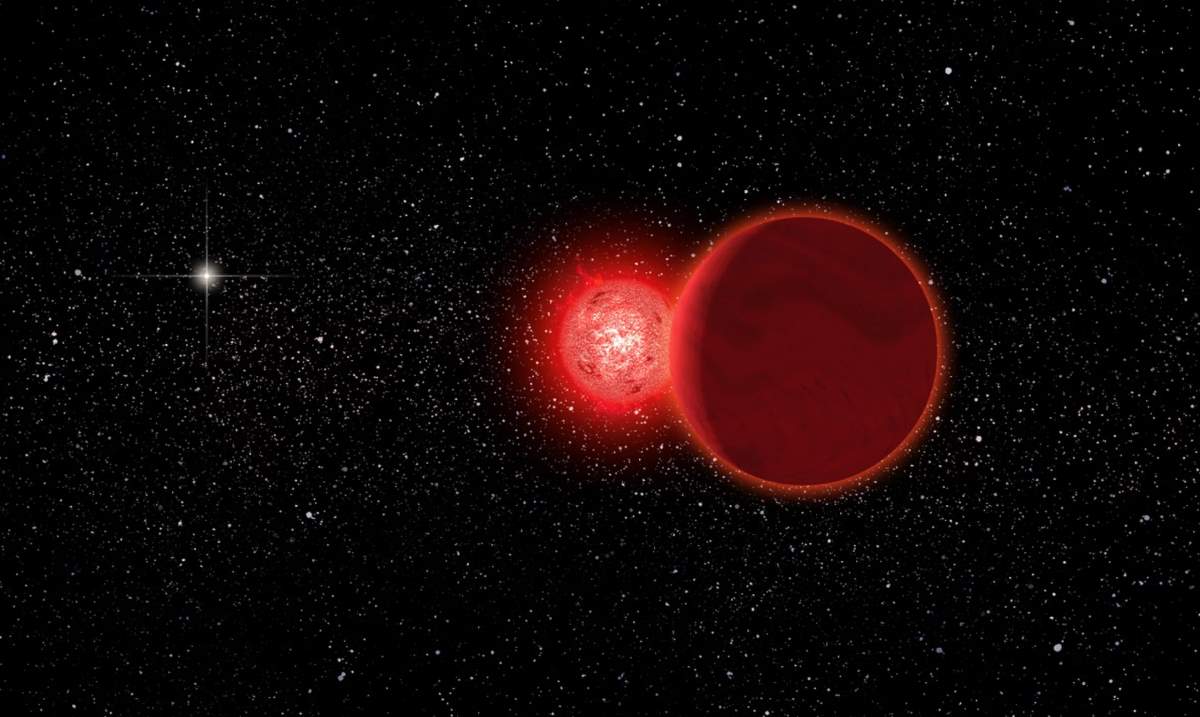Sometimes, a wondering star comes and passes so close to our Sun. Now, thanks to data provided by the Gaia spacecraft, we can know the occurrence of these close passing-bys in advance.
This potentially dangerous event last happened about 70,000 years ago, a wandering binary stellar system passed through the Solar System‘s Oort cloud (see notes 1), within 120,000 AU (0.58 pc; 1.9 ly) of the Sun. 70,000 years is just a blink of an eye compared to the Earth’s age, which is 4.543 billion years. Our ancestors were about to leave Africa at that time. The binary system is dubbed as Scholz’s Star (see notes 2), after its discoverer.
Comets perturbed from the Oort cloud would require roughly 2 million years to get to the inner Solar System. So, in the distant future, some of these comets may hit the Earth and cause mass extinctions, like the “dinosaur killer” Chicxulub impactor which impacted a few miles from the present-day town of Chicxulub in Mexico around 66 million years ago.

Now, according to a study published in the summer of 2017, by Coryne Bailer-Jones, a researcher from the Max Planck Institute for Astronomy, now we have refined estimates on when the next close-encounters will be happening. After consulting data from the European Space Agency’s (ESA) Gaia spacecraft, Bailer-Jones concluded that the Solar System can expect 16 close encounters over the course of the next 5 million years. According to his research, The closest encounter is Gl 710, a K dwarf long-known to come close to the Sun in about 1.3 million years.
Here is the abstract of the study:
I report on close encounters of stars to the Sun found in the first Gaia data release (GDR1). Combining Gaia astrometry with radial velocities of around 320,000 stars drawn from various catalogs, I integrate orbits in a Galactic potential to identify those stars which pass within a few parsecs (see notes 3).
Such encounters could influence the solar system, for example through gravitational perturbations of the Oort cloud. 16 stars are found to come within 2 pc (2 parsecs – although a few of these have dubious data). This is fewer than were found in a similar study based on Hipparcos data, even though the present study has many more candidates. This is partly because I reject stars with large radial velocity uncertainties (>10 km s−1), and partly because of missing stars in GDR1 (especially at the bright end).
The closest encounter found is Gl 710, a K dwarf long-known to come close to the Sun in about 1.3 Myr (million years). The Gaia astrometry predicts a much closer passage than pre-Gaia estimates, however: just 16,000 AU (90% confidence interval: 10,000-21,000 AU), which will bring this star well within the Oort cloud. Using a simple model for the spatial, velocity, and luminosity distributions of stars, together with an approximation of the observational selection function, I model the incompleteness of this Gaia-based search as a function of the time and distance of the closest approach.
Applying this to a subset of the observed encounters (excluding duplicates and stars with implausibly large velocities), I estimate the rate of stellar encounters within 5 pc averaged over the past and future 5 Myr to be 545±59 Myr-1. Assuming a quadratic scaling of the rate within some encounter distance (which my model predicts), this corresponds to 87 ± 9 Myr-1 within 2 pc. More accurate analysis and assessment will be possible with future Gaia data releases.
The Next Intruder: Gliese 710
“Something wicked this way comes.” – W. Shakespeare, Macbeth, Act 4, Scene 1
Currently is 63.8 light-years (19.6 parsecs) from Earth in the constellation Serpens, Gliese 710 is a 0.6 M☉ star in the constellation Serpens Cauda. It is expected to pass through our Solar System’s Oort cloud around 1.3 million years from now. Its distance at the closest approach is expected to be a mere 0.07 light-years or about 4300 AU (Astronomical Unit, see notes 3). For comparison, Proxima Centauri, currently the nearest star to the Sun, is about 4.25 light-years away.
According to astronomers Filip Berski and Piotr Dybczyński, “This event will be the strongest disrupting encounter in the future and history of the solar system” At that close distance, it would be similar in brightness to a bright planet, at an apparent visual magnitude of about -2.7 (brighter than Mars), with a total proper motion around one arcminute per year.
A much more deadly scenario is a rogue star passing through the inner parts of the solar system. It would be catastrophic. The approaching star could alter the planets’ orbits (the bigger the rogue planet, the worse the danger) and drag Earth into an extreme and inhospitable orbit (too close to or too far from the Sun). It could even kick us out of the solar system.
But this is also very unlikely. Bailer-Jones says: “No star we know of has anything but an extremely small probability of entering the inner solar system. It’s too small a target: the distance from the Earth to the Sun is around 50,000 times smaller than the distance to the edge of the Oort cloud.”

Related: Horrible ways Earth could die
Notes
- The Oort cloud sometimes called the Öpik-Oort cloud is a theoretical cloud of predominantly icy planetesimals believed to surround the Sun to as far as somewhere between 50,000 and 200,000 AU (0.8 and 3.2 light-years). It is named after astronomer Jan Oort, who first theorized its existence. 1 AU (Astronomical Unit) is the distance between Earth and Sun, which is now defined as exactly 149,597,870,700 meters (about 150 million kilometers, or 93 million miles).
- Scholz’s Star is a dim binary stellar system about 17-23 light-years (5.1-7.2 parsecs) from the Sun in the southern constellation of Monoceros near the galactic plane. It was discovered in 2013 by astronomer Ralf-Dieter Scholz. The surprising discovery about the binary system came around two years later: in 2015, Eric Mamajek (as of 2017, he is the Deputy Program Chief Scientist of the NASA Exoplanet Exploration Program -ExEP) and collaborators reported the system passed through the Solar System’s Oort cloud roughly 70,000 years ago and dubbed it Scholz’s Star.
- The parsec (symbol: pc) is a unit of length used to measure large distances to astronomical objects outside the Solar System. A parsec is defined as the distance at which one astronomical unit subtends an angle of one arcsecond, which corresponds to 648000/π astronomical units (an astronomical unit the average distance between Earth and the Sun, which is about 93 million miles or 150 million kilometers). One parsec is equal to about 3.26 light-years (30 trillion km or 19 trillion miles) in length. To put things into perspective, the nearest star, Proxima Centauri, is about 1.3 parsecs (4.2 light-years) from the Sun. Most of the stars visible to the unaided eye in the night sky are within 500 parsecs of the Sun.
Sources
- “Now We Know When Stars Will Be Passing Through The Oort Cloud” on universal-sci.com
- Study: “The completeness-corrected rate of stellar encounters with the Sun from the first Gaia data release.” C.A.L. Bailer-Jones. arxiv.org
- Scholz’s Star on Wikipedia
- Gliese 710 on Wikipedia
- Space Shuttle Endeavour’s Touchdown Meets Columbia’s Salute [An amazing photo from the past] - February 29, 2024
- Moon Landings: All-Time List [1966-2024] - February 23, 2024
- From Orbit to Ordinary: 10 Earthly Applications of Space Technology - January 23, 2024
